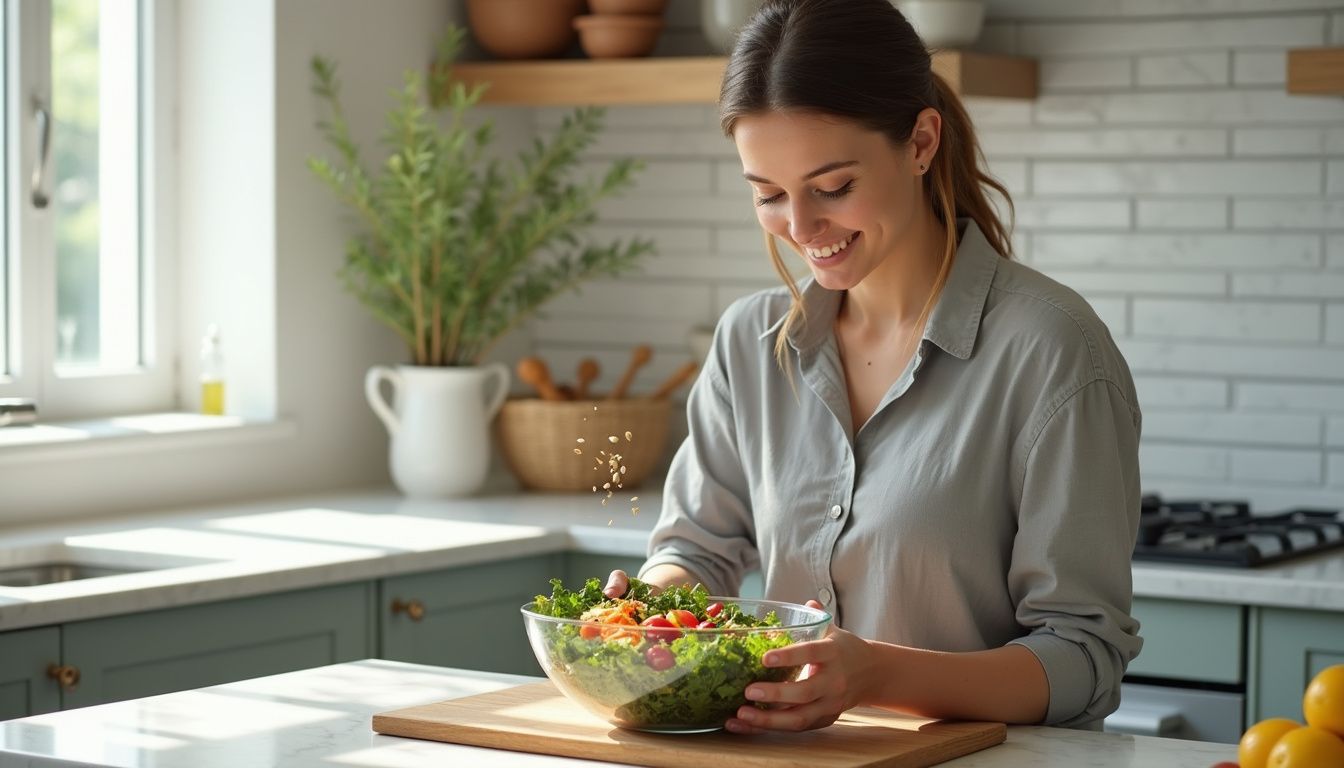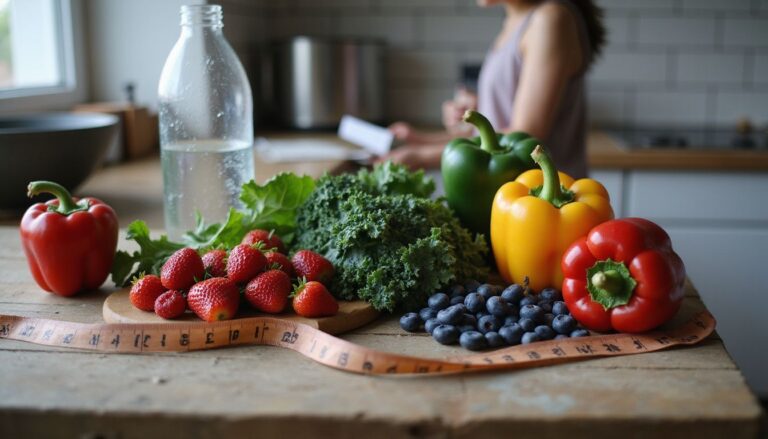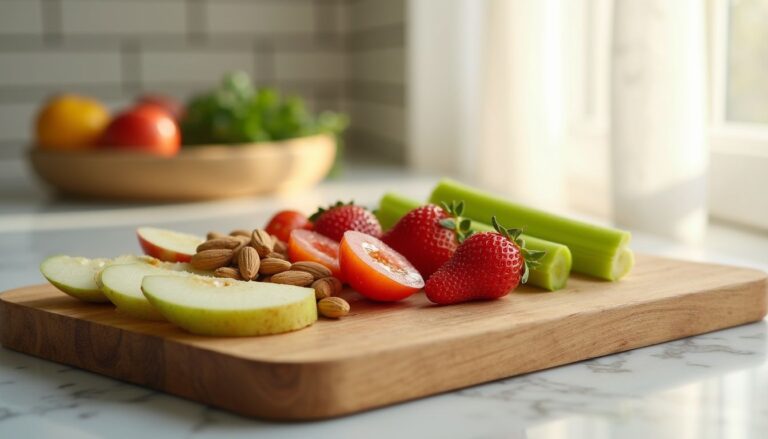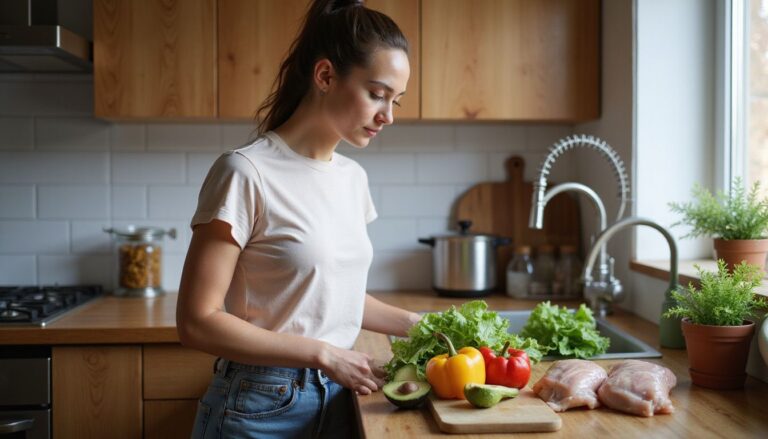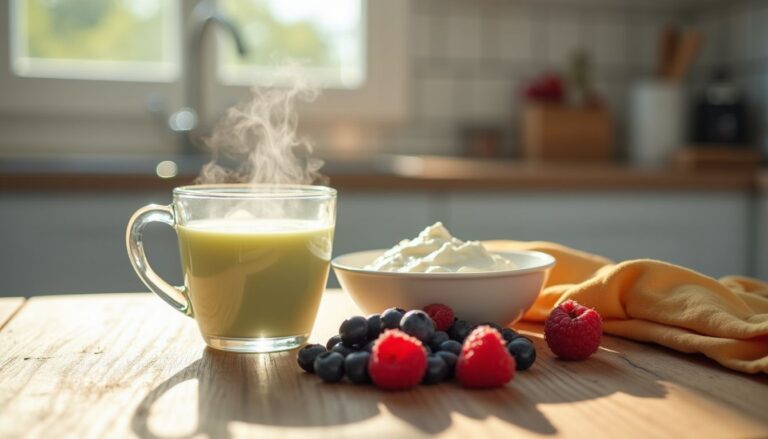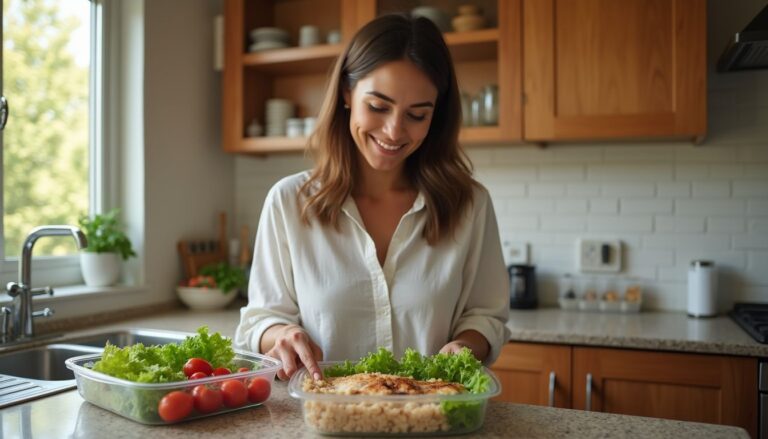Top 7 High Fiber Foods For Weight Loss: Boost Your Health With Fiber-Rich Vegetables
Our Nutrition Assistant AI Suite will transform your body. You will lose fat, get toned, and build muscle. Gain confidence and optimal health.
If losing weight feels hard, constant hunger can make it tougher. Choosing high-fiber foods helps you feel full, supports healthy digestion, and can lower total calories without strict rules. Fiber-rich foods are simple to add to your plate, and they bring many health perks.
This guide shows easy ways to include more fiber-rich vegetables and other foods high in fiber. You will learn practical tips, serving ideas, and how to increase fiber safely. Use these steps to move closer to your weight goals while caring for your gut health.
Keep reading for the best sources of dietary fiber that taste great and keep you satisfied.
Key Takeaways
- Adults should aim for at least 28 grams of fiber a day, based on the Dietary Guidelines for Americans 2020 to 2025. Hitting this target can support weight loss and regular digestion.
- Top fiber-rich vegetables include broccoli, Brussels sprouts, carrots, sweet potatoes, artichokes, spinach, and beets. Examples: broccoli has about 5 grams per cup cooked, and artichokes reach about 9.6 grams per cup cooked.
- Other high-fiber foods, such as legumes, whole grains like quinoa and barley, nuts and seeds like chia seeds, and fruits, improve fullness and gut health.
- Increase fiber slowly and drink more water. This reduces bloating and gas as your body adjusts to a higher-fiber diet.
- Whole foods beat fiber supplements for appetite control and nutrition. Chewing real food helps you feel satisfied and delivers more vitamins and minerals.
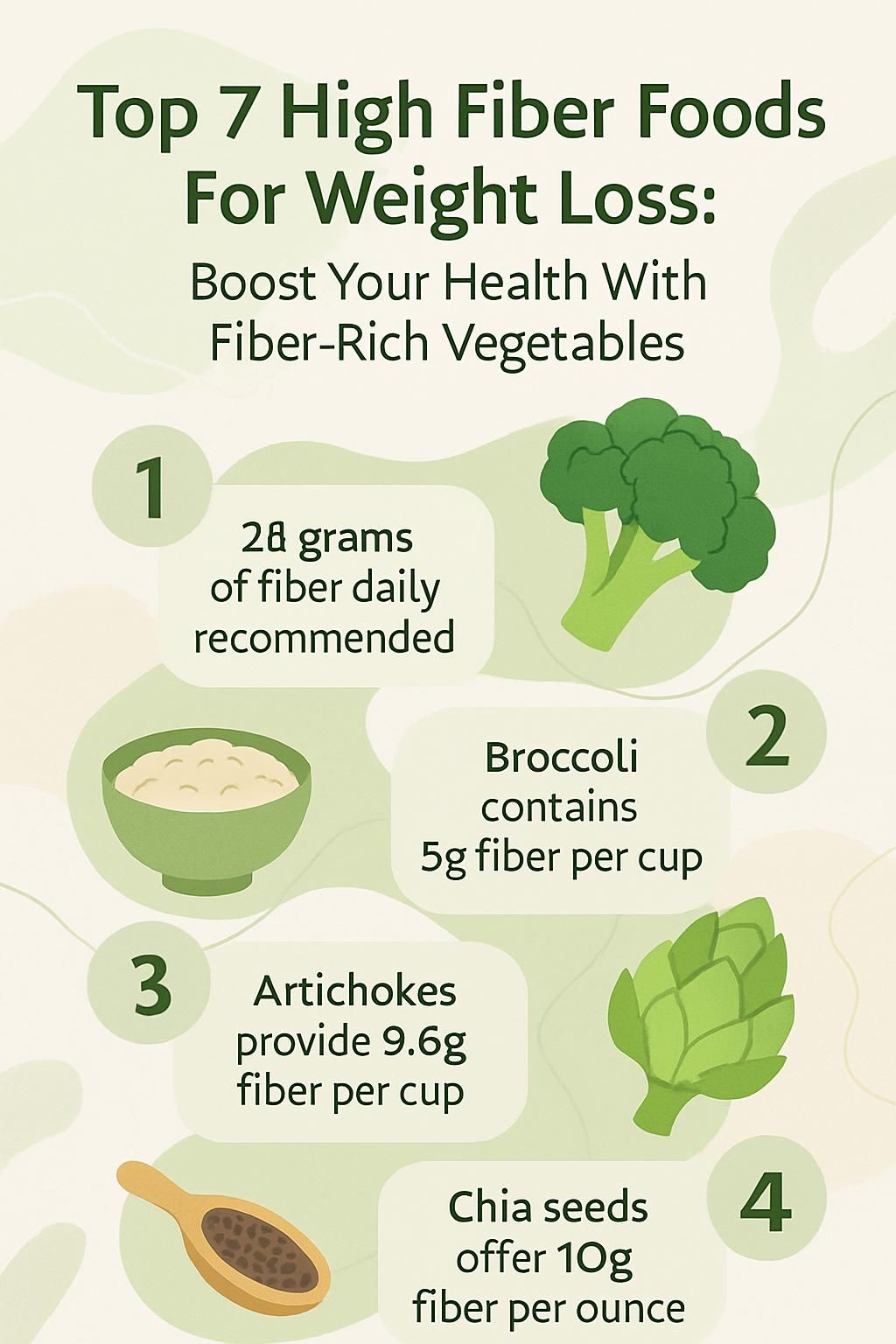
Why Is Fiber Important for Weight Loss?
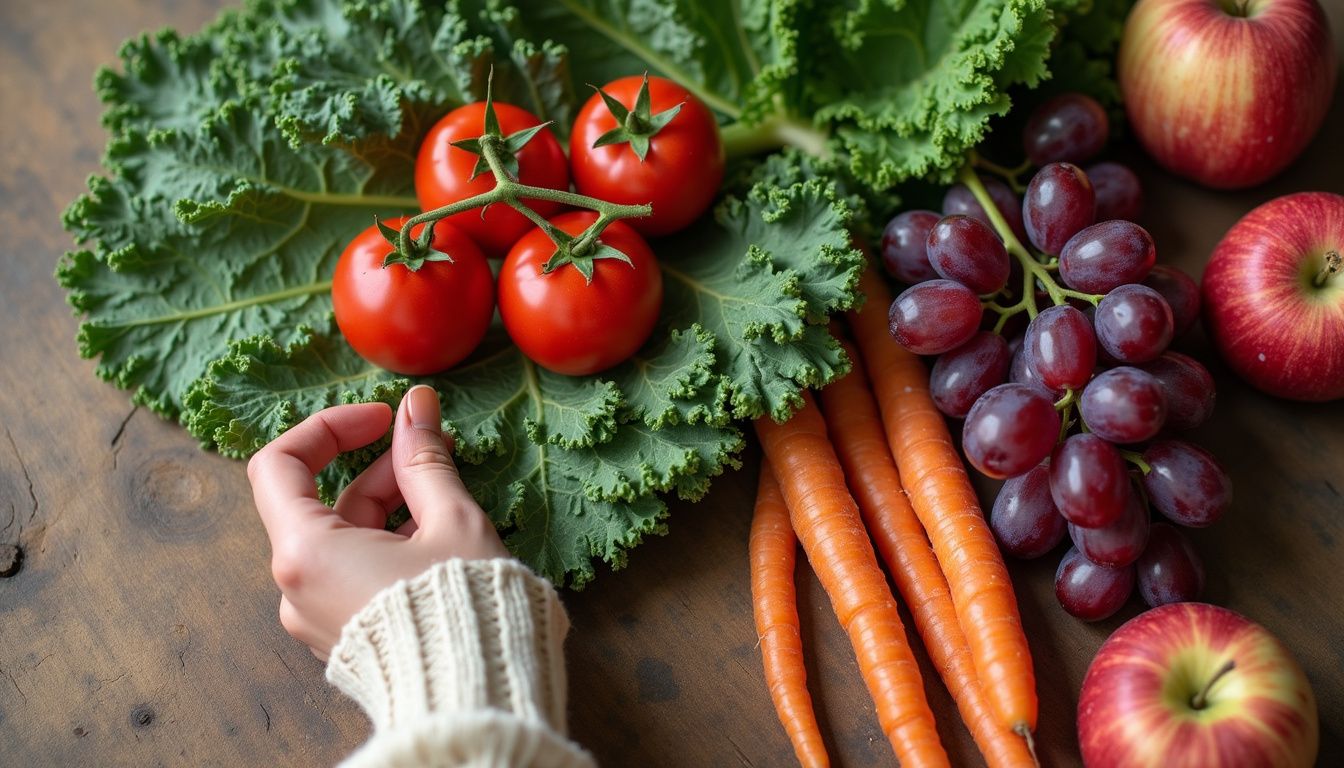
Fiber helps with weight loss because it fills you up on fewer calories. It also supports steady digestion and blood sugar, which makes it easier to stick to a healthy eating pattern. In short, fiber helps you eat less and feel better.
How does fiber help you feel full?
Soluble fiber absorbs water and forms a gel in your stomach. This slows stomach emptying, so you feel full for longer. Foods high in fiber also take more chewing, which gives your body time to register fullness.
As an example, a bowl with oatmeal, raspberries, and almonds can offer about 13.5 grams of fiber. That is enough to curb hunger for hours. Swapping a low-fiber snack for beans or fruit at lunch can reduce late-day cravings.
Whole, high-fiber foods add bulk to meals, helping you stay satisfied without constant snacking.
What role does fiber play in digestion and metabolism?
Fiber keeps your digestive system moving. Insoluble fiber adds bulk to stool, which helps manage constipation. Soluble fiber feeds good gut bacteria, which create short-chain fatty acids. These fatty acids fuel colon cells and support healthy metabolism.
People with obesity often have different gut bacteria patterns than people at a healthy weight. A diet rich in fiber from whole grains, fruits, and vegetables can support a more diverse microbiome and more stable energy. Limiting ultra-processed foods also helps, since they usually contain very little fiber.
Dietitians often point to the Dietary Guidelines for Americans 2020 to 2025. They encourage plant-based protein sources like lentils and chickpeas, plus plenty of vegetables, to raise daily fiber intake without relying on supplements.
Top 7 High Fiber Foods for Weight Loss
Many vegetables offer a high amount of fiber for few calories. These options help with appetite control and gut health while you work toward a healthy weight.
Broccoli: What makes it a nutrient-packed vegetable?
Broccoli is a fiber-rich, low-calorie veggie that supports weight management. One cup of boiled, chopped broccoli provides about 5 grams of fiber. Even a half cup cooked supplies roughly 2.5 grams.
Broccoli also delivers vitamin C and potassium. Try it raw with hummus, or roast it with olive oil and spices. Regular intake can support digestion, reduce constipation, and promote steady energy through the day.
Brussels Sprouts: Why are they fiber-rich cruciferous vegetables?
Brussels sprouts are part of the cruciferous vegetable family, along with cabbage and kale. One cooked cup, about 156 grams, offers up to 6.4 grams of fiber. You get both soluble and insoluble fiber, which helps with fullness and regularity.
They also contain antioxidants that support colon health. Roast, steam, or sauté them. Add them to salads for crunch and a reliable fiber boost in each serving.
Carrots: How are they low-calorie and high in fiber?
Carrots are a smart, low-calorie way to raise fiber intake. One medium raw carrot has about 25 calories and roughly 1.5 grams of fiber. A half cup cooked gives up to 2.3 grams with little fat or added sugar.
Carrots bring vitamin A and antioxidants that support heart and colon health. Snack on raw sticks, or toss chopped carrots into soups and salads. Both the soluble and insoluble fiber help steady blood sugar and digestion.
Sweet Potatoes: Why are they a filling alternative to regular potatoes?
Sweet potatoes keep you fuller for longer due to their fiber and slow-digesting starch. A cup of cooked sweet potato contains about 6.4 grams of fiber. That is typically higher than a medium baked white potato with skin.
They also supply vitamin A and potassium. Bake, roast, or mash them as a side or base for bowls. Their steady digestion supports even energy and fewer hunger spikes between meals.
Artichokes: How do they provide fiber and antioxidants?
Artichokes are among the highest in fiber for vegetables. One cup cooked provides about 9.6 grams of fiber. Add them to salads, pasta, or grill them as a side for a flavorful boost.
They also offer antioxidants that protect cells and support heart health. The mix of fiber and antioxidants supports fullness and healthy digestion without adding many calories.
Spinach: What health benefits does this leafy green offer?
One cooked cup of spinach provides about 2.2 grams of fiber along with vitamins A, C, and K. It also has iron and magnesium. These nutrients support energy, immunity, and bone health.
Spinach blends easily into salads, omelets, and smoothies. Pair it with healthy fats like avocado or chia seeds to increase nutrient absorption. Regular intake can support bowel regularity and a balanced diet.
Beets: How do beets boost fiber intake?
Beets add color, flavor, and fiber. About 100 grams of cooked beetroot offers roughly 2 grams of fiber. They also contain antioxidants and natural nitrates that support overall wellness.
Roast beets as a side, slice them into salads, or grate them into slaws. If your eating pattern is low in vegetables, beets are an easy way to get more fiber from food rather than supplements.
Other Fiber-Rich Foods to Complement Your Diet
Beyond vegetables, you can meet your fiber goals with legumes, whole grains, nuts, seeds, and fruit. Pairing these with high-fiber vegetables builds satisfying meals that support digestion and weight control.
Which legumes are high in fiber?
Legumes combine fiber and plant-based protein, which helps you feel full longer.
- Split peas, boiled: about 16 grams of fiber per cup
- Lentils, boiled: about 15.5 grams per cup
- Black beans, boiled: about 15 grams per cup
- Canned beans like Cannellini, Navy, or Great Northern: about 13 grams per cup
- Kidney beans, cooked: about 5.7 grams per half cup
- Chickpeas, cooked: about 6.2 grams per half cup
Use them in soups, stews, grain bowls, and salads. Rinsing canned beans lowers sodium and makes them easier to digest.
What whole grains provide good fiber sources?
Whole grains offer fiber plus minerals and B vitamins. They also pair well with vegetable-rich meals.
- Whole-wheat spaghetti, cooked: about 6.0 grams per cup
- Pearled barley, cooked: about 6.0 grams per cup
- Bran flakes: about 5.5 grams per three-fourths cup
- Quinoa, cooked: about 5.0 grams per cup
- Oat bran muffin, medium: about 5.0 grams each
- Instant oatmeal, prepared: about 4.0 grams per serving
- Air-popped popcorn: about 3.5 to 5.8 grams per 3 cups
- Brown rice, cooked: about 3.5 grams per cup
Check the nutrition facts label and choose products with higher fiber per serving. These swaps help you get your fiber from food while keeping meals simple.
Which nuts and seeds are best for fiber?
Nuts and seeds add fiber, healthy fats, and crunch to meals and snacks.
- Chia seeds: about 10 grams per ounce, about 4.1 grams per tablespoon
- Almonds: about 3.5 grams per ounce, around 23 almonds
- Pistachios: about 3 grams per ounce, about 49 nuts
- Sunflower kernels: about 3 grams per quarter cup
- Flaxseeds: rich in fiber and easy to blend into smoothies or oatmeal
Sprinkle them over yogurt, cereal, salads, or cooked grains. Start with small amounts if you are new to high-fiber seeds.
What fruits are rich in fiber?
Fruits bring fiber, water, and natural sweetness. Many are easy to carry and eat on the go.
- Raspberries: about 8 grams per cup
- Pear, medium: about 5.5 grams
- Apple with skin, medium: about 3 to 4.5 grams
- Avocado, whole: up to about 10 grams
- Orange, medium: about 3 grams
- Banana, medium: about 3 grams
- Strawberries: about 3 grams per cup, about 2 grams per half cup sliced
- Plums and other berries: useful additions to raise daily fiber
Adding berries to oatmeal or yogurt can keep you full longer through busy mornings.
How Do Fiber-Rich Vegetables Benefit Weight Loss?
Think of fiber as a steady hand for appetite, digestion, and blood sugar. It keeps your routine stable while you build healthier habits.
How does fiber help control appetite?
Fiber slows how fast your stomach empties, which extends feelings of fullness. High-fiber foods are less calorie dense, so you can eat a larger volume for fewer calories.
A bean and vegetable salad with around 11 grams of fiber can keep you satisfied far longer than a low-fiber drink. Chewing fibrous foods also uses more energy and gives your brain time to sense fullness.
In what ways does fiber improve gut health?
Fiber feeds your gut bacteria, which supports a balanced microbiome. These microbes break down certain fibers and make short-chain fatty acids that help keep your intestines healthy.
Regular fiber intake supports consistent bowel movements and less constipation. Research comparing traditional high-fiber diets and modern low-fiber diets shows differences in gut bacteria diversity, which can affect metabolism and comfort.
Choosing whole grains and a variety of vegetables increases total fiber. Many people feel less bloating and more regularity after a few weeks of steady intake.
How can fiber reduce bloating and water retention?
Fiber holds water in the digestive tract and adds bulk to stool. With enough fluids, this makes stools easier to pass and helps relieve constipation. As waste moves more regularly, belly bloating often decreases.
Increase fiber slowly and watch how your body responds. A gradual approach, paired with more water, reduces gas and cramping while your gut adjusts.
How does fiber stabilize blood sugar levels?
Soluble fiber forms a gel in your gut that traps sugars and slows their absorption. This helps prevent sharp spikes in blood sugar after meals and supports steady energy.
Vegetables like broccoli and spinach, along with whole grains, can make blood sugar easier to manage. Diets high in fiber are linked with a lower risk of diabetes and better glucose control.
How Can You Incorporate More Fiber-Rich Foods into Your Diet?
Small changes add up. Use these simple ideas to increase fiber intake without overhauling every meal.
How to add vegetables to every meal?
Blend spinach or kale into a morning smoothie. Add grated carrots or beets to oatmeal or eggs. At lunch, load salads with raw broccoli, Brussels sprouts, and carrots.
Layer leafy greens into sandwiches and wraps. At dinner, mix roasted sweet potatoes and artichokes into soups, stews, and stir-fries for extra fiber and staying power. For snacks, keep baby carrots with hummus or nut butter.
Combining several vegetables in one dish makes meals more filling without a big calorie hit.
How to replace refined grains with whole grains?
Swap white bread for whole-wheat bread. Choose whole-wheat pasta instead of regular pasta. Pick brown rice, wild rice, barley, quinoa, or old-fashioned oats.
For breakfast, go with bran flakes or oatmeal, not sugar-heavy cereals. Read labels and select items with more fiber per serving. Whole grains provide both soluble and insoluble fiber, which supports steady blood sugar and digestion.
What are good fiber-rich snack options?
Keep simple, portable snacks on hand. Mix sweet options with savory picks to stay interested and on track.
| Snack Option | Serving Size | Fiber (g) |
|---|---|---|
| Air-popped popcorn | 3 cups | 3.5 to 5.8 |
| Apple | Medium | 4.5 |
| Pear | Medium | 5.5 |
| Almonds | 1 ounce | 3.5 |
| Pistachios | 1 ounce | 3 |
| Carrot, raw | Medium | 1.5 to 2 |
| Sunflower kernels | Quarter cup | 3 |
These choices help with weight loss because they are filling and nutrient dense, not empty calories.
How to include spinach or kale in smoothies?
Add a handful of fresh or frozen spinach or kale to your favorite fruit smoothie. The taste stays mild, especially with berries, mango, or banana. For more fiber, include a tablespoon of chia seeds or ground flaxseeds.
Start small if you are new to green smoothies. Many people enjoy baby spinach because it blends smoothly. This habit can help you meet daily fiber goals with almost no extra effort.
What Are Common Myths About High Fiber Foods?
Clearing up myths can make it easier to choose fiber-rich foods with confidence.
Is it true that high fiber foods are bland or boring?
High-fiber foods can be full of flavor. Roast broccoli or Brussels sprouts with olive oil, garlic, and spices. Add raw carrots for crunch and beets for a hint of sweetness and color.
Healthy fats from nuts and seeds plus herbs and spices boost taste without piling on calories. Fiber-rich meals can look bright and taste great.
Does fiber cause digestive discomfort?
Increasing fiber too fast can cause gas, cramping, diarrhea, or bloating. Your gut needs time to adjust as bacteria ferment new fibers. Raise your intake gradually and drink plenty of water.
If you feel discomfort, scale back a bit and increase more slowly. Pay attention to your body’s signals and choose the foods that feel best for you.
Are only fruits good sources of fiber?
Fruits are helpful, but many foods are rich in fiber. Vegetables, whole grains, legumes, nuts, and seeds can deliver more fiber per serving than most fruits.
For example, a cup of cooked lentils has about 15 grams of fiber, while a medium apple has around 4 grams. Swapping white rice for quinoa or adding black beans to salads can help you meet your goal faster.
What Precautions Should You Take When Increasing Fiber Intake?
Raising fiber is safe for most people. Still, a few smart steps make the transition smoother and more comfortable.
Why should you increase fiber gradually?
Large, sudden jumps in fiber can cause gas, cramping, or bloating. Many people eat less fiber than recommended, so the gut needs time to adapt. Increase by a few grams each week until you reach your daily target.
If you have digestive concerns or chronic conditions, talk with a registered dietitian or your healthcare provider before making big changes.
How does drinking water help with fiber digestion?
Soluble fiber works best with water, forming a soft gel that moves easily through your intestines. Insoluble fiber also needs fluids to keep waste moving well.
Drink plenty of water as you add more fiber. Hydration helps prevent constipation, reduces gas, and eases the shift to a higher-fiber eating pattern.
How to monitor your body’s response to fiber?
Watch for symptoms like gas, bloating, diarrhea, or cramping. Keep a simple food and symptom log for a week or two. Adjust the amount and type of fiber based on how you feel.
If problems persist or worsen, seek guidance from a registered dietitian or healthcare professional. Most mild issues improve with more water and a slower increase in fiber.
FAQs About High Fiber Foods and Weight Loss
These quick answers can help you plan meals with confidence and clarity.
How much fiber should I eat daily?
Aim for about 14 grams of fiber per 1,000 calories you eat. On a 2,000-calorie diet, that is about 28 grams a day for most adults and teens. Children ages 12 to 23 months need about 19 grams a day, according to national guidelines.
Planning meals with vegetables, beans, fruits, and whole grains makes this goal realistic. Tracking intake for a week can show where to add a serving or two.
Can fiber supplements aid weight loss?
Fiber supplements like psyllium can help you feel less hungry and may raise total fiber intake. Still, they do not match the full benefits of fiber-rich foods. Whole foods provide vitamins, minerals, and chewing time, which help with satisfaction.
If you use supplements, think of them as a backup. Focus on getting most of your fiber from vegetables, fruits, legumes, nuts, seeds, and whole grains.
What are soluble and insoluble fibers?
Soluble fiber dissolves in water and forms a gel. It slows digestion, helps lower cholesterol, and increases fullness. You can find it in oats, beans, apples, and carrots.
Insoluble fiber does not dissolve in water. It adds bulk to stool and helps waste move through the large intestine. Eat both types from plants to support digestion and weight control. Many experts suggest adults get about 25 to 38 grams of total fiber daily, based on the Dietary Guidelines for Americans issued in 2020.
Conclusion
Choosing high-fiber foods can help you lose weight and feel better day to day. Vegetables such as broccoli, Brussels sprouts, carrots, sweet potatoes, artichokes, spinach, and beets are flavorful, filling, and rich in nutrients.
Increasing your fiber intake supports fullness, regular digestion, and stable blood sugar. Pair these vegetables with legumes and whole grains to reach your daily fiber goal. Start with small changes and build from there.
Information in this article is for education and does not replace medical advice. For personal guidance, consult a registered dietitian or healthcare professional. Sources: Dietary Guidelines for Americans, 2020 to 2025; research on fiber, the microbiome, and metabolic health.
FAQs
1. What are the top seven high fiber foods for weight loss?
The leading high fiber foods that support weight loss include lentils, black beans, chickpeas, broccoli florets, Brussels sprouts, collard greens, and raspberries. Each provides a rich source of dietary fiber which can help you feel full longer and manage calorie intake. According to the USDA FoodData Central database, one cup of cooked lentils contains about 15 grams of fiber while a cup of raspberries offers around 8 grams.
2. How do vegetables rich in fiber promote weight loss?
Fiber-rich vegetables slow digestion and increase satiety; this helps reduce overall food consumption throughout the day. Studies published in The American Journal of Clinical Nutrition show that diets higher in plant-based fibers are linked to lower body weights over time.
3. Can eating more high-fiber foods improve health beyond weight control?
Yes; consuming more dietary fiber from sources like legumes and leafy greens supports digestive health by promoting regular bowel movements and feeding beneficial gut bacteria. Research from Harvard T.H. Chan School of Public Health indicates that increased vegetable intake lowers risks for heart disease and type 2 diabetes.
4. What is an easy way to add these high-fiber foods into daily meals?
You can mix black beans or chickpeas into salads or soups; steam broccoli florets as a side dish; blend raspberries into smoothies; or sauté collard greens with garlic for extra flavor and nutrients. In my own experience preparing weekly meal plans with at least two servings of these vegetables per day made it easier to reach recommended daily fiber goals without much effort.
Summary: High-fiber vegetables such as lentils, black beans, chickpeas, broccoli florets, Brussels sprouts, collard greens, and raspberries offer significant benefits for those seeking healthy weight management along with improved digestive function and reduced chronic disease risk.

